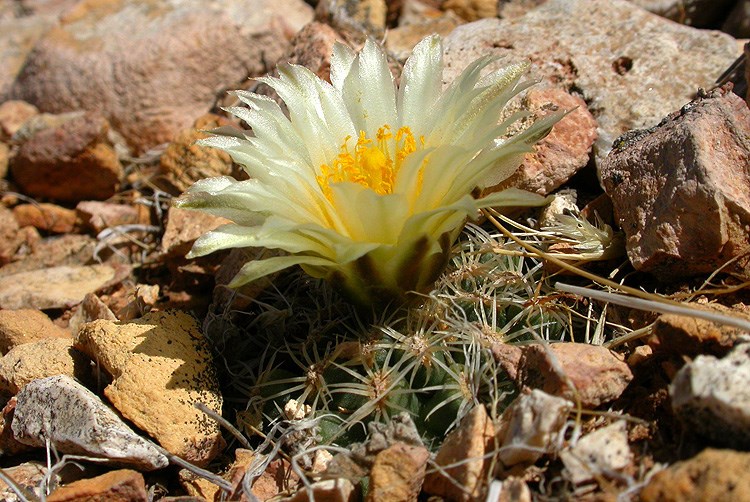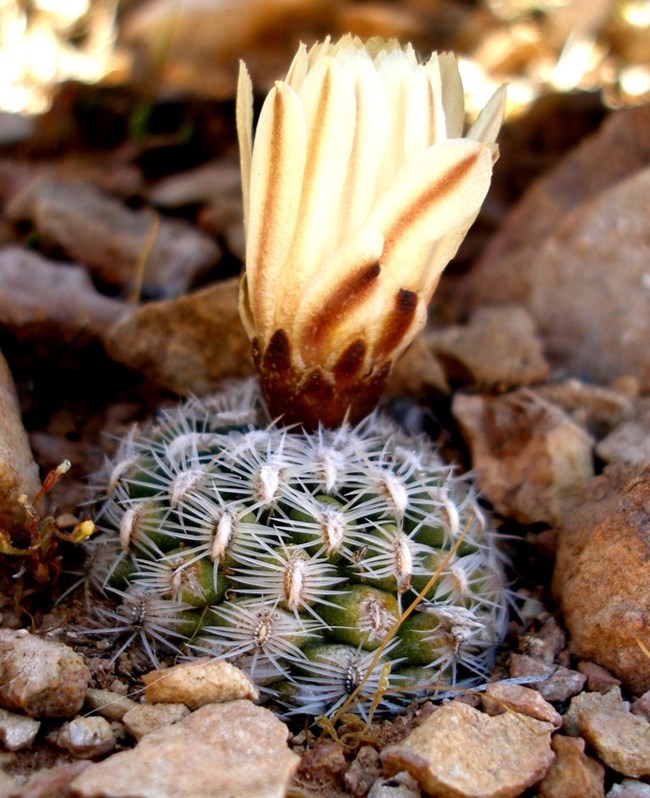Last updated: September 18, 2025
Article
Get to Know the Plateau - Brady's Pincushion Cactus

Brady's Pincushion Cactus - Pediocactus bradyi

Christopher L. Christie
Habitat and Ecology
Brady’s pincushion cactus grows in scattered populations over a 27 square mile area near Marble Canyon along the Colorado River in Arizona. Its soil requirements are specialized: it grows only on chips of Kaibab limestone that overlay soils derived from Moenkopi shale and sandstone outcrops. These soils occur along gently sloping benches at 3,860 to 4,490 feet in elevation. The sites have sparse vegetation of low shrubs, annuals, and grasses. Brady’s pincushion cactus was only discovered in 1958 and historically may have occurred northeast along the Colorado River from its current distribution. Currently, it occurs in only 10-20% of its potential habitat.
Description
Brady’s pincushion cactus is an inconspicuous, rounded cactus. It usually has one stem that grows up to 2.4 inches tall and 2 inches in diameter. Clusters of fourteen to fifteen straw-colored spines radiate from a point that is elliptical in shape. The spines have somewhat comb-like hairs, and their tips point downward. From late March into April, a straw-yellow flower blooms at the end of each stem. The green fruit, which contains brownish-black seeds, turns reddish-brown at maturity, usually in late May to early June. During drought, the cactus often will retract completley into the soil.

Daniela Roth CC BY-SA
Conservation Status and Threats
The US Fish and Wildlife Service has listed Brady’s pincushion cactus as an endangered species since October 26, 1979. Arizona lists the cactus as critically imperiled.
It was once thought that Brady’s pincushion cactus is primarily threatened by collectors of rare cacti, especially since populations are easily accessible from the highway, but there is very little evidence to support that. Brady’s pincushion cactus is threatened by off-road vehicles, uranium mining, and livestock grazing. Because it is restricted to a specific soil type and has a small gene pool, it is particularly vulnerable to extinction. The vast majority of mortality however is attributed to natural causes such as death by rodents, larvae, disease, and drought.
Of Note
Extensive surveys were done on the Navajo (Diné) Nation, but researchers still could only locate a small ammount of Brady’s pincushion cactus. Some data does suggest that there are more young cactus being established than are experecing mortality, offering hope that this species will continue to thrive around the small place that it exists.

Daniela Roth CC BY-SA
References
Arizona Game and Fish Department. 1994. Plant abstracts. Heritage Data Management System, Arizona Game and Fish Department, Phoenix, AZ. Available at http://www.azgfd.gov/w_c/edits/documents/Pedibrad. fo_000.pdf (accessed 14 June 2010).
Heil, D.K., and J. M. Porter. 1993. Pediocactus bradyi. Flora of Northa America, volume 4, page 213.
Hughes, Lee. 2005. Brady’s Pincushion Cactus. Desert Plants. Volume 21, Number 2. University of Arizona and Bureau of Land Management
U.S. Fish and Wildlife Service. 1985. Brady pincushion cactus (Pediocactus bradyi) recovery plan. U.S. Fish and Wildlife Service, Albuquerque, NM.
Written by Kelly Reeves for the Southern Colorado Plateau Network (2010)
Printable .pdf version
